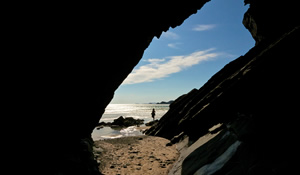Landscape and Industry
Sublime mountains, ancient ruins, picturesque villages and rain, lots of rain. These seem to be some of the constant ingredients in the descriptions of Wales in travel accounts by many continental Europeans. But Wales has drawn foreign visitors for other reasons than the desire to look at gnarled trees and white-washed little cottages scattered across the countryside.
The mountains of Snowdonia and the Brecon Beacons have been praised since the Romantic period for their rugged beauty – and they have also been cursed for their inaccessibility. To seek out solitude and breath-taking views, travellers have scaled these mountains on foot, on horseback or driven in post coaches. They have cruised along the narrow roads to escape civilisation only to find that the last room in the inn had been booked just hours before by other continental tourists, as the German doctor Carl Carus discovered, much to his dismay, in Aberystwyth one evening in 1844. For many artists who sought inspiration, damp weather or the presence of other tourists were no deterrent. The Bavarian painter Hubert von Herkomer had a bespoke portable hut delivered to the banks of Llyn Ogwen to brave the weather and Onorato Carlandi from Italy took to hiding in bushes in order to observe local customs without disturbing the people.
With the rise of industry, continental visitors sought out the coalfields, the iron- and steelworks of south Wales and the slate quarries in the north. Whereas continental European countries were only starting to build up their own industries in the first half of the nineteenth century, Wales was already at the forefront of new modes of transportation, such as trains and steamboats, and industrial architecture. The bustling town life, the noisy inventions, the hellfire atmosphere of the factories and the impressive new bridges filled many travellers to Wales with awe. The Menai Suspension Bridge, the Pontcysyllte Aqueduct or the Dowlais Ironworks received praise as beacons of Europe's future. Many a tour through Wales during those years of industrial expansion was just thinly disguised industrial espionage.
And then there is the rain. Drizzle cuts short picnics on the shores of Llyn Tegid. Showers follow ramblers over hills and through valleys. Storms prevent the departure of ships from Holyhead and Fishguard. However, travellers' accounts give the impression that the centre of precipitation in Wales is located on the top of Snowdon. Many travellers have braved the mountain in the hope of catching sight of the Wicklow Mountains in Ireland. But instead, they stared in disbelief at mountains of rain clouds, valleys of fog and other wet mountaineers. Even though the promised view may not have extended further than a few feet, a cup of warm coffee and a slice of cheese and bread have raised the dampened spirits of many a bedraggled mountaineer, at least since the 1840s when the first wooden summit huts opened their doors to paying customers.
Set between mountains and hills, today the ruins of Tintern Abbey and Strata Florida continue to be sought out by continental travellers as much as the disused parts of Penrhyn Quarry or Big Pit in Blaenavon – all glistening with rainwater as the sun breaks through the clouds after the most recent shower.


